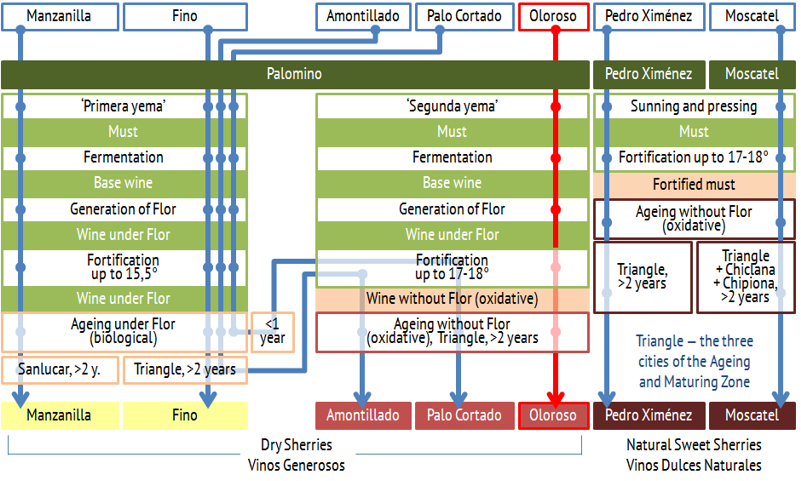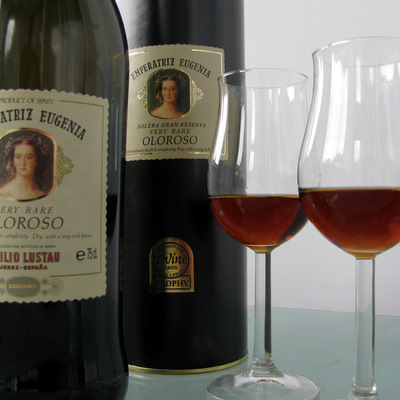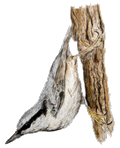
- Sherry Wine:
- Production
- Classification
- Cities & Bodegas
- Tastings
- Analogues
- Authors & Contacts
- Ðóññêèé ñàéò
Sherry wine types
Oloroso
Olga Nikandrova and Denis Shumakov.
Oloroso is a dry oxidatively-aged sherry.

In producing Oloroso the following moments are essential.
First, to produce the base wine which is to become Oloroso sherry after years of ageing the second extraction must of Palomino grape is used.
Second, Oloroso-to-be is fortified up to 17-18° — this kills flor which has formed during the racking of the base wine and precludes further presence of any other yeasts in the wine.
Third, dynamical ageing is not critical for producing Oloroso — the wine may be just as wonderful being aged statically (in the Añada system). Nevertheless, most Olorosos are aged in the Criaderas and Solera system (two years minimum), its blending qualities perfectly fit into the concept of sherry production.
Forth, with ageing Oloroso gains alcoholic strength (water evaporates from the wine through the pores of barrels, and at that Oloroso has no flor, which could consume alcohol) and becomes more concentrated — sometimes even too concentrated so a dose of Pedro Ximénez may be added into very old Olorosos to make them taste milder.
Proper Oloroso is dry wine of 17-22° alcoholic strength with sugar content not exceeding 5 grams per liter. Its color may be different — from amber to mahogany. Oloroso is full-bodied, well-structured wine with an elegant dry aftertaste. In its taste and aroma one can feel baked, balsamic and woody notes as well as hazelnut, tobacco, dry fallen leaves, spices, truffles and leather.
Oloroso’s closest neighbors in the sherry range are Amontillado and Palo Cortado. Their common difference from Oloroso is the raw materials used for their production (first extraction must for Amontillado and Palo Cortado versus second extraction must for Oloroso). Amontillado also differs from Oloroso also by the fact that it undergoes full-scale biological ageing while Oloroso has but a negligibly short contact with flor — only until it is fortified. Palo Cortado also undergoes biological ageing, but it can be very short — so by this parameter it does not differ from Oloroso all that much.
Oloroso, as well as other oxidatively-aged sherries, may become the basis for the following sherry specialties.
1. Old sherries certified as V.O.S. è V.O.R.S. — that is sherries with average age of 20 and 30 years respectively. And other old sherries.
2. Vintage sherries. Usually they will be labeled with the word Añada (as a synonym for the word “vintage” and direct reference to the static ageing method) and, naturally, the year of the vintage.
3. Non-systemic specialties, like single barrel sherries.
Besides, the word “Oloroso” is often used in synonymic names of some blended sherries. For example, Cream may be called Sweet Oloroso, and Medium — Oloroso Avocado or Rich Oloroso.
The etymology of the word is quite simple. Oloroso in Spanish means “fragrant”, “odorous”, “flavorful”. Absolutely just epithets for a good sherry.

Oloroso may be like this, for example
A comprehensive and no-lose glass for Oloroso may be a special sherry Catavino. Other variations depend completely on the style of drinking sherry. If you are going to have it on its own, with some tapas or with very light snacks, you may want to downscale the glass-ware up to a small distillate glass, for example. If Oloroso is to be paired with main dishes, the glass may be enlarged — up to a white wine glass.
Traditional serving temperature for Oloroso is 12-14°C. But you can just as well vary its cooling degree. It will be tasty anyway.
The Regulatory Council recommends to pair Oloroso with mature cheeses, meat stews (goes well with rabbit stew, tested repeatedly), game, red tuna tataki, boeuf bourguignon, coq au vin and other nice things. Such precise recommendations indicate that Oloroso may accompany almost any good meat dish (except too spicy one, of course).
We consider Oloroso the most harmonious and rich in gustatory nuances sherry (with an obvious reservation that anything can happen). It is ideal for long and dainty savoring or for drinking it incidentally to bring casual and proper joy into daily life.
Oloroso is recommended to open and consume within three years after bottling. To our opinion this rather severe restriction is just only to certain wines. Uncorked and closed again bottle of Oloroso can be stored in the fridge for a month and a half without any notable loss of quality.
Olorosos reviewed on the website (in Russian only):
— Lustau Oloroso Emperatriz Eugenia
— Lustau Oloroso Don Nuño
— González Byass Matusalem
— Bodegas San Sebastián Oloroso Seco
— Harveys Gran Solera
— Lustau Single Cask Pilar Aranda Dry Oloroso
— Pedro’s Almacenista Selection Oloroso
— Oloroso Alexandro
— Lustau Oloroso Pata de Gallina (Almacenista Juan García Jarana)
— Barbadillo Cuco Oloroso Seco
— González Byass Alfonso Oloroso
— Alvear Oloroso Asunción
Read next — Amontillado.
Warning!
This site can contain information about drinks excessive consumption of which may cause harm to health and is unadvisable for people who didn’t come of age.
Share Sherry
- Sherry.wine, FEDEJEREZ
- Copa Jerez, Sherry Week
- Sherry Notes, Jerez de Cine
- Los Generosos, Criadera
- Jerez-Xeres-Sherry
- Los Vinos de Jerez
Articles
- There are more articles in Russian than in English in this website. Sorry :(
Reviews
- To our great regret, we didn’t have time to translate tasting and traveling notes into English. But, if you want, you can see them in Russian.

